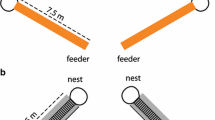Summary
-
1.
The desert ant,Cataglyphis bicolor, is able to orient towards the pattern of polarized light in the sky even without perceiving information on the sun's position. The accuracy of artificially induced homing courses is not influenced by performing the experiments just before sunrise and after sunset or by shading the sun.
-
2.
However, after destroying the polarization pattern by appropriate filtering of the skylight (Figs. 1 and 2) the azimuth of the sun was found to be sufficient when working as an isolated orientation parameter (Fig. 5). No influence of the sun's altitude could be shown by mirror experiments (Fig. 6b).
-
3.
By artificially shifting the sun's azimuth either during the foraging or during the return run the sun's azimuth competes with the polarization pattern. In that situation the sun has no influence on direction finding (Fig. 6a and b).
-
4.
The ants tested beneath various colour folios working as large sized spectral filters do not show any direction finding capacities as soon as wavelengths shorter than 410 nm are cut off (Fig. 7). This holds irrespective of whether the sun is visible or not. The accuracy of the homing courses is totally restored by means of an edge filter transmitting in the range λ λ 390 nm (Fig. 9).
-
5.
The results strongly support the hypothesis that only the uv.-receptors are involved in polarization analysis.
Similar content being viewed by others
References
Autrum, H., Kolb, G.: Spektrale Empfindlichkeit einzelner Sehzellen der Aeschniden. Z. vergl. Physiol.60, 450–477 (1968)
Autrum, H., Zwehl, V. v.: Die spektrale Empfindlichkeit einzelner Sehzellen des Bienenauges. Z. vergl. Physiol.48, 357–384 (1964)
Batschelet, E.: Statistical methods for the analysis of problems in animal orientation and certain biological rhythms. Amer. Inst. of Biol. Sciences, Washington (1965)
Birukow, G.: Lichtkompassorientierung beim WasserläuferVelia currens (Heteroptera) am Tage und zur Nachtzeit. Z. Tierpsychol.13, 463–484 (1956)
Birukow, G., Valois, C. de: Über den Einfluß der Höhe einer Lichtquelle auf die Lichtkompaßorientierung des MistkäfersGeotrupes silvaticus. Naturwissenschaften42, 349–350 (1957)
Bruckmoser, P.: Die spektrale Empfindlichkeit einzelner Sehzellen des RückenschwimmersNotonecta glauca (Heteroptera). Z. vergl. Physiol.59, 187–204 (1968)
Duelli, P.: The relation of astromenotactic and anemomenotactie orientation mechanisms in desert ants,Cataglyphis bicolor (Formicidae, Hymenoptera). In: Information processing in the visual systems of Arthropods, p. 281–286, R. Wehner, Ed. Berlin-Heidelberg-New York: Springer 1972
Eguchi, E.: Fine structure and spectral sensitivities of retinular cells in the dorsal sector of compound-eyes in the dragonflyAeschna. Z. vergl. Physiol.71, 201–218 (1971)
Frisch, K. v.: Tanzsprache und Orientierung der Bienen. Berlin-Heidelberg-New York: Springer 1965
Frisch, K. v., Lindauer, M., Schmeidler, F.: Wie erkennt die Biene den Sonnenstand bei geschlossener Wolkendecke? Naturw. Rundschau13, 169–172 (1960)
Gogala, M.: Die spektrale Empfindlichkeit der Doppelaugen vonAscalaphus macaronius. Z. vergl. Physiol.57, 232–243 (1967)
Hess, P.: Die spektrale Energieverteilung der Himmelsstrahlung. Beitr. Geophys.55, 204–220 (1939)
Jander, R.: Die optische Richtungsorientierung der roten Waldameise (Formica rufa). Z. vergl. Physiol.40, 162–238 (1957)
Jander, R.: Die Hauptentwicklungsstufen der Lichtorientierung bei den tierischen Organismen. Naturwiss. Rundschau18, 318–324 (1965)
Kiepenheuer, J.: Die Rolle verschiedener Reizparameter von Lichtquellen bei der Orientierung der roten WaldameiseFormica polyctena. Dissertation Universität Frankfurt/M. (1971)
Kirschfeld, K.: Die notwendige Anzahl von Rezeptoren zur Bestimmung der Richtung des elektrischen Vektors linear polarisierten Lichtes. Z. Naturforsch.27 b, 578–579 (1972)
Lindauer, M.: Sonnenorientierung der Bienen unter der Äquatorsonne und zur Nachtzeit. Naturwissenschaften44, 1–6 (1957)
Mote, M. I., Goldsmith, F. H.: Spectral sensitivities of colour receptors in the compound eye of the cockroachPeriplaneta. J. exp. Zool.173, 137–146 (1970)
New, D. A. T.: Effects of small zenith distances of the sun on the communication of honey bees. J. Insect Physiol.6, 196–208 (1961)
Pardi, L., Papi, F.: Die Sonne als Kompaß beiTalitrus saltator (Amphipoda, Talitridae). Naturwissenschaften39, 262–263 (1952)
Rozenberg, G. V.: Twilight. A study in atmospheric optics. New York: Plenum Press (1966)
Santschi, F.: Observations et remarques critiques sur le méchanisme de l'orientation chez les fourmis. Rev. suisse Zool.19, 303–338 (1911)
Santschi, F.: Les differentes orientations chez les fourmis. Rev. Zool. Afric.11, 111–144 (1923)
Shurcliff, W. A.: Polarized light. Production and use. Cambridge/Mass.: Harvard Univ. Press 1962
Wehner, R.: Visual orientation performance of desert ants,Cataglyphis bicolor, towards astronomenotactic directions and horizon landmarks. Proc. AIBS Symp. Animal Orientation and Navigation, p. 421–436, S. R. Galleret al., Eds. Washington: U.S. Gov. Print. Off. 1972
Wehner, R., Brunnert, R., Herrling, P., Klein, R.: Periphere Adaptation und zentralnervöse Umstimmung im optischen System vonCataglyphis bicolor (Fomicidae, Hymenoptera). Revue Suisse Zool.79, 197–228 (1972)
Wehner, R., Duelli, P.: The spatial orientation of desert ants,Cataglyphis bicolor, before sunrise and after sunset. Experientia (Basel)27, 1364–1366 (1971)
Wehner, R., Toggweiler, F.: Verhaltensphysiologischer Nachweis des Farbensehens beiCataglyphis bicolor (Formicidae, Hymenoptera). J. comp. Physiol.77, 239–255 (1972)
Author information
Authors and Affiliations
Additional information
The work was financially supported by Akademie der Wissenschaften und der Literatur, Mainz. In addition, grant no. 3.315.70 of the Fonds National Suisse de la Recherche Scientifique paid for the experimental equipment. We further want to thank the Ciba-Geigy AG Basel, for medicamental supply.
Rights and permissions
About this article
Cite this article
Duelli, P., Wehner, R. The spectral sensitivity of polarized light orientation inCataglyphis bicolor (Formicidae, Hymenoptera). J. Comp. Physiol. 86, 37–53 (1973). https://doi.org/10.1007/BF00694476
Received:
Published:
Issue Date:
DOI: https://doi.org/10.1007/BF00694476




